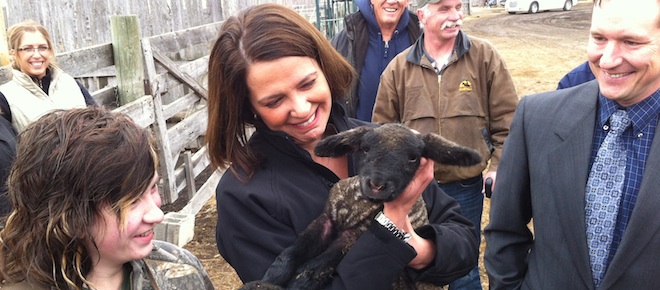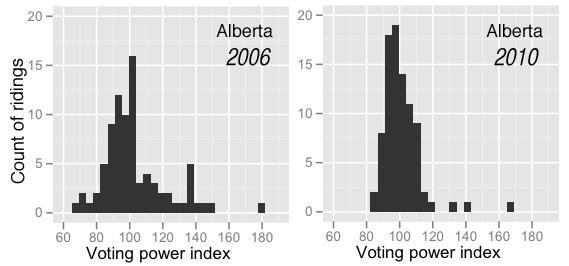Ba-a-a-attle for the Alberta voter
The early days of the Alberta election showcase the Wildrose tacticians at their best
Share

To kick off the Alberta election, here’s Danielle Smith with some sheep, as featured on Wildrose.ca. This should not be taken as some sort of sly joke about voters, either on her part or on mine. It’s an excellent photo-op, and will be all over the news this morning; it is literally irresistible. In general, the early days of the campaign have me formidably impressed with the Wildrose tacticians. I imagine, if only because I’m used to pretty slapstick Alberta oppositions, that some snickering comic-book brain-thing in a jar is using servomotor arms to thrust and slam the levers of a great machine. But it’s probably nothing as romantic as all that; just Tom Flanagan dashing off a few memos.
Why is Danielle Smith messing about with mutton? What you notice instantly is that it is hard to the imagine the austere, intellectual lawyer Alison Redford mucking about amidst the sheepdip and talking country with mustachioed gentlemen in overalls. I might be wrong; I expect she’ll give it a go. But Smith just looks more comfortable in this setting than one can easily imagine Redford being. She’s having fun. Does Premier Redford ever have fun? I suspect her idea of fun is a lot like mine: locking the door and settling in with Grotius’s Mare Liberum or Mao’s Great Famine or something.
Redford’s team can’t allow the election to be defined by this sort of thing. The winning ground for the premier to fight on is accomplishment, not personality. Danielle Smith has been a newspaper columnist. She sat on a school board for a bit. Alison Redford helped bring democracy to South Africa and the Balkans. Honestly, which one are you going to trust with the top job, given only that information?
But an election is not an LSAT test, and Redford’s first months in office have not been auspicious. She won her party’s leadership, as Ralph Klein did in 1992, on a challenge to the torpid old guard; once in office, she kept the old boys (and purged the women). She offended core Conservative constituencies with early initiatives: roadside trials for not-really-drunk drivers, controversial intrusions into home schools, slipperiness on “fixed” election dates and on a promised judicial inquiry into government intimidation of physicians. In a time of austerity she passed a budget with a 3% spending increase—with a massive 11th-hour bribe to doctors made too late to be counted.
Some of this is politics as usual in Alberta, especially that last one. But even the most adamantine cynicism must recoil at the gag law which prevents Elections Alberta from disclosing the outcomes into its investigations of illegal donations to the Progressive Conservative party and its constituency associations. As Smith explained in a press release that got swamped by the election call, the former CEO of Elections Alberta had recommended that such investigations “shall be conducted in private”. In the eventual text of the election law (passed when Redford was justice minister), this maxim became a permanent oath of silence: Elections Alberta officials can never publicly identify guilty individuals, corporations, or political parties.
This has led us to the bizarre spectacle of corrupt politicians and institutions being “censured” in secret—and if a secret censure sounds like a contradiction to you, that’s because it is one. (Does someone get yelled at in a locked room? What does this even mean?) Redford now says, in the face of this absurdity, that the secrecy is intended to prevent a “McCarthyism approach” to investigations of illegal kickbacks. You’ll recall, though Alberta’s educated premier doesn’t, that McCarthyism targeted people for their ideas—not, say, for skimming money for partisan purposes from schoolchildren and the disabled. When Danielle Smith is done frolicking with biblical mammals, she may move on fairly briskly to challenging Redford’s ethical standards, and that could be promising ground to fight on, too.
* * *
 As a sort of postscript, the Conservatives do deserve credit for upholding transparency and justice in one matter: the late re-drafting of electoral boundaries, completed in 2010. By 2006, the effort to keep roughly equal population sizes in each Alberta constituency had fallen apart; the histogram at left here illustrates this nicely, with its strong resemblance to a bombed-out skyscraper. Ridings are plotted on the diagram according to the influence or “power” of each eligible voter in them, with the provincial average defined as 100. As you can hopefully reckon for yourself, some voters in the 2008 election were literally twice as influential as others: there were almost 40,000 voters in Calgary-North West but fewer than 20,000 in Drayton Valley-Calmar. Only half the ridings were within 10% of the overall average population.
As a sort of postscript, the Conservatives do deserve credit for upholding transparency and justice in one matter: the late re-drafting of electoral boundaries, completed in 2010. By 2006, the effort to keep roughly equal population sizes in each Alberta constituency had fallen apart; the histogram at left here illustrates this nicely, with its strong resemblance to a bombed-out skyscraper. Ridings are plotted on the diagram according to the influence or “power” of each eligible voter in them, with the provincial average defined as 100. As you can hopefully reckon for yourself, some voters in the 2008 election were literally twice as influential as others: there were almost 40,000 voters in Calgary-North West but fewer than 20,000 in Drayton Valley-Calmar. Only half the ridings were within 10% of the overall average population.
After redistricting, the vote power is bunched within much tighter limits: half the ridings are now within 6% of the average population, and no riding is twice as populous as any other. The mathemagical skyscraper stands tall and proud on a narrow base, as justice and the country’s sacred Charter of Rights demand. (Nerd note: by the Gini coefficient, a measure of inequality usually used in discussions of income, the overall “inequality” of Alberta voting power moved from 0.1 to 0.05, where perfect equality would be zero.)
By a comic twist of fate, past inequalities in riding populations worked in favour of the Conservatives; the map is always evolving more slowly than population is changing, so the Alberta PCs (and the Socreds before them) benefited from relative strength in depleting rural areas, just as the federal Liberals long profited from their largesse to parts of Canada that were emptying out. Fairness has now given Edmonton one new seat and Calgary two in the legislature—and this happens just as the PCs have chosen an urbane, liberal leader, one who will claim many votes from tribal large-L Liberals in both cities.
The Wildrose Party, for its part, is strongest in some of the rural southern patches most favoured under the old distribution of power, but reduced to relative equality under the new. Maybe Miss Smith should switch from lambs to urban chickens.